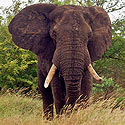|
Proboscidea
(elephants, mammoths)
Life
>
Eukaryotes >
Opisthokonta >
Metazoa (animals) > Bilateria > Deuterostomia >
Chordata > Craniata > Vertebrata (vertebrates) >
Gnathostomata (jawed vertebrates) > Teleostomi (teleost
fish) > Osteichthyes (bony fish) > Class:
Sarcopterygii (lobe-finned fish) > Stegocephalia
(terrestrial vertebrates) > Reptiliomorpha > Amniota >
Synapsida (mammal-like reptiles) > Therapsida > Theriodontia
> Cynodontia > Mammalia (mammals)
> Placentalia (placental mammals) >
Afrotheria > Paenungulata > Tethytheria
Species indigenous to southern Africa
Loxodonta africana (African elephant) African elephants are the largest living land mammals
(maximum weight 10 000 kg, weight at birth 120 kg). As elephants grow
continuously throughout their lives, the largest member of a herd is usually the
oldest. The heaviest pair of tusks recorded, came from Kenya and weighed 102.3
kg and 97 kg respectively. Elephants live in small family groups led by an older cow
the matriarch. At times of abundant food or water several famly groups may
congregate to form a large herd. Adult bulls are solitary or from part of
smaller bachelor groups and only join the family herds when females are in
breeding condition. The elephant is one of Africa’s “Big Five”. |
 |
|
